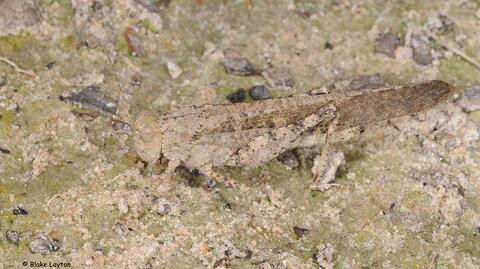Bug’s Eye View
Carolina Grasshopper Vol. 2, No. 31

Dissosteira carolina
Order: Orthoptera
Family: Acrididae
Carolina grasshoppers are big insects, ranging from 1.5 to 2 inches long, but they can still be difficult to spot when resting on bare ground, and this is where they prefer to rest when they are not feeding. These large, gray-brown grasshoppers are often encountered in open areas such as plowed fields, along dirt roads, and other areas with sparse vegetation—places where they can rest on bare ground but have plants nearby to feed on. Walk through such an area in late summer or fall and you will probably flush several. Their hind wings are black with a light yellow band along the rear margin and are visible when these grasshoppers take wing. They also make a noticeable whirling noise as they fly, and these two features make them quite conspicuous in flight. Carolina grasshoppers normally fly about 20 to 40 feet before landing back on the ground, where they are again well-camouflaged.
Males are sometimes seen hovering in mid-air, about four to six feet above the ground, in short display flights. The flashing of those black and yellow-banded hind wings, combined with the noise they make while doing this, results in a showy display that attracts females. Naturalists and hunters who are familiar with woodcock will notice several similarities between that bird and this insect: the excellent camouflage when resting on the ground; the short, noisy flight when flushed; and the noisy, showy flight to attract mates. But the nesting habits are much different. Female grasshoppers deposit their eggs an inch or so deep in the ground in pods that contain several dozen eggs each, and this is how Carolina grasshoppers overwinter.
Carolina grasshoppers are one of North America’s most widely distributed insects. They occur in every state in the continental US and in the southern part of Canada. Although they occasionally reach damaging numbers in other areas of the country, this rarely occurs here in the Southeast. In fact, serious outbreaks of grasshoppers of any species are relatively uncommon here, primarily because of our relatively high rainfall. On the rare occasions when we do have outbreaks of other species of grasshoppers, they usually occur during dry periods. High rainfall and moisture results in increased mortality of eggs and newly hatched grasshoppers and increased incidence of diseases that infect grasshoppers and help control their numbers.
Blake Layton, Extension Entomology Specialist, Mississippi State University Extension Service. The information given here is for educational purposes only. Always read and follow current label directions. Specific commercial products are mentioned as examples only and reference to specific products or trade names is made with the understanding that no discrimination is intended to other products that may also be suitable and appropriately labeled.
Sign up to receive Bug's Eye View.